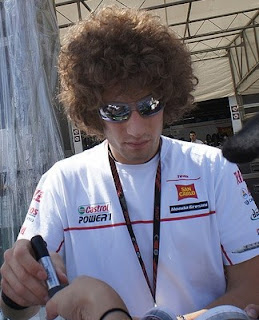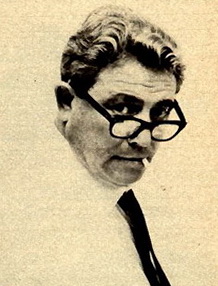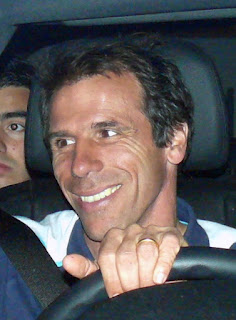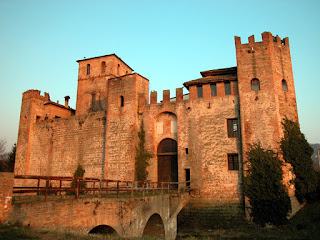Iconic glass church among legacy to city of Milan
 |
| Angelo Mangiarotti, pictured at a conference in 2007 |
Many notable examples of his work in urban design can be found in his home city, including the Repubblica and Venezia underground stations, the iconic glass church of Nostra Signora della Misericordia in the Baranzate suburb and several unique residential properties, including the distinctive Casa a tre cilindri - composed of a trio of cylindrical blocks - in Via Gavirate in the San Siro district of the city.
He also worked extensively in furniture design with major companies such as Vistosi, Fontana Arte, Danese, Artemide, Skipper and the kitchen producer Snaidero.
 |
| Inside the glass Chiesa di Nostra Signora della Misericordia |
He returned to Italy in 1950 and opened his own architectural firm in Milan with fellow architect Bruno Morassutti, a partnership which was active until 1960.
It was with Morasutti and another Milan-based designer and engineer, Aldo Favini, that Mangiarotti collaborated on the Chiesa di Nostra Signora della Misericordia, which signalled a massive change in the design features and construction techniques of Italian churches.
The church, in the Baranzate suburb to the north-west of Milan, was constructed of concrete, steel and glass - chosen as the materials that fuelled the rebirth of Italy after the devastation of the Second World War.
 |
| The Case a tre cilindri in the San Siro district of Milan |
The church is very near the Fiera Milano metro station, which was Mangiarotti's last architectural project before his death in 2012.
Mangiarotti's designs for furniture, lighting, decorative objects, ceramics and glassware remain highly collectible and sell for high prices. He also created a famous collection of Murano glass Giogali Lighting produced by Vistosi.
His partnership with Rino Snaidero, which began in 1960, helped establish Snaidero's position as a leader in kitchen design.
Mangiarotti designed the Cruscotto kitchen and Sistema lines for Snaidero, both of which were notable for the exceptionally refined materials used. The Cruscotto design was exhibited at the Museum of Modern Art in New York.
 |
| The distinctive Snaidero headquarters building |
It had rounded corners and slightly protruding elliptical windows reminiscent of a ship or an aeroplane.
Mangiarotti, who died in 2012 aged 91, passed on his ideas as a lecturer at universities and technical institutes in Venice, Palermo, Florence and Milan in Italy, as well as Lausanne in Switzerland, Hawaii and Adelaide, Australia. His work won numerous awards.
Travel tip:
The San Siro district of Milan originated as a small settlement in the 19th century in the area now known as Piazzale Lotto. The area developed in the 20th century and has since become a very diverse district, with a mix of green space and congested residential neighbourhoods, combining villas and apartment blocks serving different income groups, and a concentration of sports facilities, most notably the Giuseppe Meazza football stadium, home of AC Milan and Internazionale, the Milanese hippodrome horse racing track and the Palasport di San Siro arena, which is mainly used for basketball and volleyball.
Milan hotels from Booking.com
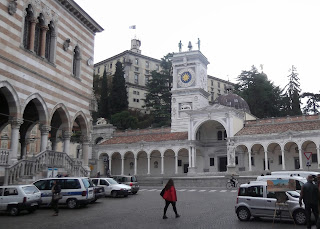 |
| The Piazza della Libertà in Udine |
Majano, the base of the Snaidero company headquarters that Mangiarotti designed, is a short distance from the city of Udine, an attractive and wealthy provincial city which is the gastronomic capital of Friuli. Udine's most attractive area lies within the medieval centre, which has Venetian, Greek and Roman influences. The main square, Piazza della Libertà, features the town hall, the Loggia del Lionello, built in 1448–1457 in the Venetian-Gothic style, and a clock tower, the Torre dell’Orologio, which is similar to the clock tower in Piazza San Marco - St Mark's Square - in Venice.
More reading:
Ulisse Stacchini, designer of two famous Milan landmarks
How Marco Zanuso's ideas put Italy at the forefront of contemporary design
Unconventional motorway church put Giovanni Michelucci on the map
Also on this day:
Home
How Marco Zanuso's ideas put Italy at the forefront of contemporary design
Unconventional motorway church put Giovanni Michelucci on the map
Also on this day:
1815: Napoleon escapes from Elba
1943: The birth of Oscar-winning set designer Dante Ferretti
Selected books:
Angelo Mangiarotti: The Tectonics of Assembly
(Picture credits: Casa di tre cilindri and Chiesa di Nostra Signora della Misericordia by Arbalete via Wikiemedia Commons)
1943: The birth of Oscar-winning set designer Dante Ferretti
Selected books:
Angelo Mangiarotti: The Tectonics of Assembly
(Picture credits: Casa di tre cilindri and Chiesa di Nostra Signora della Misericordia by Arbalete via Wikiemedia Commons)
Home










